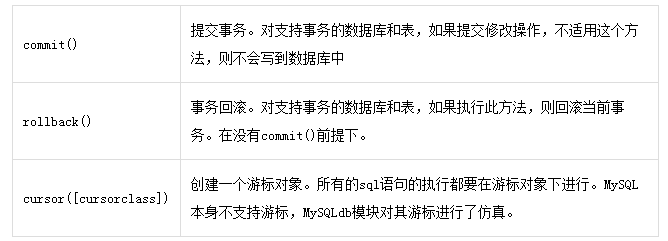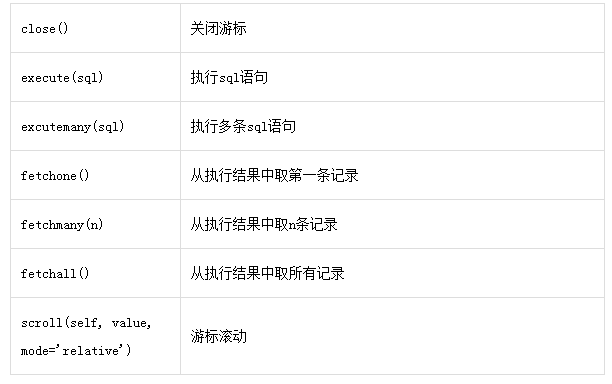Python database programming
Explain how Python operates a database and completes simple additions, deletions, modifications, and searches, taking the MySQL database as an example.
Python’s MySQL database operation module is called MySQLdb and requires additional installation.
Installation through pip tool: pip install MySQLdb
MySQLdb module, we mainly use the method MySQLdb.Connect() to connect to the database. After connecting to the database, we use some methods to perform corresponding operations. The
MySQLdb.Connect(parameters...) method provides the following commonly used parameters:

The connect() function returned by the connection object:

The cursor object also provides several methods:

13.1 Database addition, deletion and modification query
13.1.1 Create a user table in the test library and add a record
>>> conn = MySQLdb.Connect(host='192.168.1.244',user='root',passwd='QHyCTajI',db='test',charset='utf8') >>> cursor = conn.cursor() >>> sql = "create table user(id int,name varchar(30),password varchar(30))" >>> cursor.execute(sql) # 返回的数字是影响的行数 0L >>> sql = "insert into user(id,name,password) values('1','xiaoming','123456')" >>> cursor.execute(sql) 1L >>> conn.commit() # 提交事务,写入到数据库 >>> cursor.execute('show tables') # 查看创建的表 1L >>> cursor.fetchall() # 返回上一个游标执行的所有结果,默认是以元组形式返回 ((u'user',),) >>> cursor.execute('select * from user') 1L >>> cursor.fetchall() ((1L, u'xiaoming', u'123456'),)
13.1.2 Insert multiple pieces of data
>>> sql = 'insert into user(id,name,password) values(%s,%s,%s)' >>> args = [('2','zhangsan','123456'), ('3','lisi','123456'),('4','wangwu','123456')] >>> cursor.executemany(sql, args) 3L >>> conn.commit() >>> sql = 'select * from user' >>> cursor.execute(sql) 4L >>> cursor.fetchall() ((1L, u'xiaoming', u'123456'), (2L, u'zhangsan', u'123456'), (3L, u'lisi', u'123456'), (4L, u'wangwu', u'123456'))
The args variable is a list containing tuples, each tuples corresponding to each record. When querying multiple records, using this method can effectively improve insertion efficiency.
13.1.3 Delete the record of user name xiaoming
>>> sql = 'delete from user where name="xiaoming"' >>> cursor.execute(sql) 1L >>> conn.commit() >>> sql = 'select * from user' >>> cursor.execute(sql) 3L >>> cursor.fetchall() ((2L, u'zhangsan', u'123456'), (3L, u'lisi', u'123456'), (4L, u'wangwu', u'123456'))
13.1.4 Query the record
>>> sql = 'select * from user' >>> cursor.execute(sql) 3L >>> cursor.fetchone() # 获取第一条记录 (2L, u'zhangsan', u'123456') >>> sql = 'select * from user' >>> cursor.execute(sql) 3L >>> cursor.fetchmany(2) # 获取两条记录 ((2L, u'zhangsan', u'123456'), (3L, u'lisi', u'123456'))
13.1.4 Return the results in dictionary form
默认显示是元组形式,要想返回字典形式,使得更易处理,就用到cursor([cursorclass])中的cusorclass参数。
传入MySQLdb.cursors.DictCursor类:
>>> cursor = conn.cursor(MySQLdb.cursors.DictCursor)
>>> sql = 'select * from user'
>>> cursor.execute(sql)
3L
>>> cursor.fetchall()
({'password': u'123456', 'id': 2L, 'name': u'zhangsan'}, {'password': u'123456', 'id': 3L, 'name': u'lisi'}, {'password': u'123456', 'id': 4L, 'name': u'wangwu'})13.2 Traverse the query results
#!/usr/bin/env python
# -*- coding: utf-8 -*-
import MySQLdb
try:
conn = MySQLdb.Connect(host='127.0.0.1', port=3306, user='root', passwd='123456', connect_timeout=3, charset='utf8')
cursor = conn.cursor()
sql = "select * from user"
cursor.execute(sql)
for i in cursor.fetchall():
print i
except Exception, e:
print ("Connection Error: " + str(e))
finally:
conn.close()
# python test.py
(2L, u'zhangsan', u'123456')
(3L, u'lisi', u'123456')
(4L, u'wangwu', u'123456')Use a for loop to traverse the query results and add Exception handling.

Hot AI Tools

Undresser.AI Undress
AI-powered app for creating realistic nude photos

AI Clothes Remover
Online AI tool for removing clothes from photos.

Undress AI Tool
Undress images for free

Clothoff.io
AI clothes remover

Video Face Swap
Swap faces in any video effortlessly with our completely free AI face swap tool!

Hot Article

Hot Tools

Notepad++7.3.1
Easy-to-use and free code editor

SublimeText3 Chinese version
Chinese version, very easy to use

Zend Studio 13.0.1
Powerful PHP integrated development environment

Dreamweaver CS6
Visual web development tools

SublimeText3 Mac version
God-level code editing software (SublimeText3)

Hot Topics
 1664
1664
 14
14
 1423
1423
 52
52
 1321
1321
 25
25
 1269
1269
 29
29
 1249
1249
 24
24
 PHP and Python: Different Paradigms Explained
Apr 18, 2025 am 12:26 AM
PHP and Python: Different Paradigms Explained
Apr 18, 2025 am 12:26 AM
PHP is mainly procedural programming, but also supports object-oriented programming (OOP); Python supports a variety of paradigms, including OOP, functional and procedural programming. PHP is suitable for web development, and Python is suitable for a variety of applications such as data analysis and machine learning.
 Choosing Between PHP and Python: A Guide
Apr 18, 2025 am 12:24 AM
Choosing Between PHP and Python: A Guide
Apr 18, 2025 am 12:24 AM
PHP is suitable for web development and rapid prototyping, and Python is suitable for data science and machine learning. 1.PHP is used for dynamic web development, with simple syntax and suitable for rapid development. 2. Python has concise syntax, is suitable for multiple fields, and has a strong library ecosystem.
 How to run sublime code python
Apr 16, 2025 am 08:48 AM
How to run sublime code python
Apr 16, 2025 am 08:48 AM
To run Python code in Sublime Text, you need to install the Python plug-in first, then create a .py file and write the code, and finally press Ctrl B to run the code, and the output will be displayed in the console.
 PHP and Python: A Deep Dive into Their History
Apr 18, 2025 am 12:25 AM
PHP and Python: A Deep Dive into Their History
Apr 18, 2025 am 12:25 AM
PHP originated in 1994 and was developed by RasmusLerdorf. It was originally used to track website visitors and gradually evolved into a server-side scripting language and was widely used in web development. Python was developed by Guidovan Rossum in the late 1980s and was first released in 1991. It emphasizes code readability and simplicity, and is suitable for scientific computing, data analysis and other fields.
 Python vs. JavaScript: The Learning Curve and Ease of Use
Apr 16, 2025 am 12:12 AM
Python vs. JavaScript: The Learning Curve and Ease of Use
Apr 16, 2025 am 12:12 AM
Python is more suitable for beginners, with a smooth learning curve and concise syntax; JavaScript is suitable for front-end development, with a steep learning curve and flexible syntax. 1. Python syntax is intuitive and suitable for data science and back-end development. 2. JavaScript is flexible and widely used in front-end and server-side programming.
 Golang vs. Python: Performance and Scalability
Apr 19, 2025 am 12:18 AM
Golang vs. Python: Performance and Scalability
Apr 19, 2025 am 12:18 AM
Golang is better than Python in terms of performance and scalability. 1) Golang's compilation-type characteristics and efficient concurrency model make it perform well in high concurrency scenarios. 2) Python, as an interpreted language, executes slowly, but can optimize performance through tools such as Cython.
 Where to write code in vscode
Apr 15, 2025 pm 09:54 PM
Where to write code in vscode
Apr 15, 2025 pm 09:54 PM
Writing code in Visual Studio Code (VSCode) is simple and easy to use. Just install VSCode, create a project, select a language, create a file, write code, save and run it. The advantages of VSCode include cross-platform, free and open source, powerful features, rich extensions, and lightweight and fast.
 How to run python with notepad
Apr 16, 2025 pm 07:33 PM
How to run python with notepad
Apr 16, 2025 pm 07:33 PM
Running Python code in Notepad requires the Python executable and NppExec plug-in to be installed. After installing Python and adding PATH to it, configure the command "python" and the parameter "{CURRENT_DIRECTORY}{FILE_NAME}" in the NppExec plug-in to run Python code in Notepad through the shortcut key "F6".




